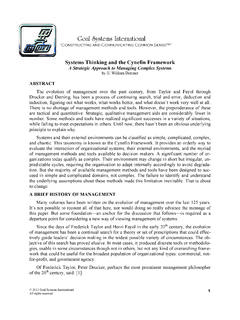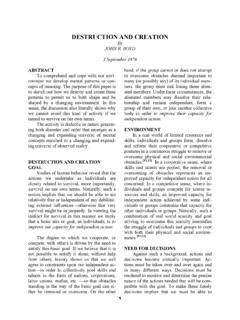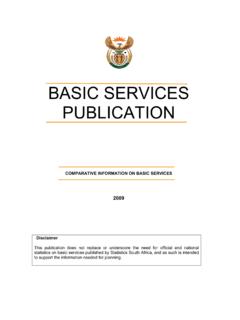Transcription of Part-1-Intro to Systems Approach - Goal Sys
1 Copyright Goal Systems International, 2006 This is the first of a series of 12 articles on Systems thinking, a way of understanding complexorganizations and society offering significant promise for improving the leadership and management ofcommercial companies, not-for-profit organizations, and government 1An Introduction to theSystems ApproachBy H. William DettmerThere is no question that in our age there is a good deal of turmoil about the manner in whichsociety is run. Probably at no point in the history of man has there been so much discussionabout the rights and wrongs of the policy [Citizens have] begun to suspect that thepeople who make the major decisions that affect our lives don't know what they are don't know what they are doing simply because they have no adequate basis to judge theeffects of their decisions.
2 To many it must seem that we live in an age of moronic decisionmaking. C. West ChurchmanThe Systems Approach [Introduction][1:vi]Sounds like Churchman is talking about us today, doesn't it? The preceding quotation comes from theintroduction to his seminal book on Systems thinking,The Systems Approach , written in 1968. That's sadtestimony to the fact that few decision makers in the world have learned much about complex Systems inthe last 37 years. In the immortal words of Winston Churchill, Man will occasionally stumble over thetruth, but usually he just picks himself up and continues on.
3 We've been continuing on for four decades. It's time to go back and revisit that truth we stumbled overin 1968. We can snicker at the fact that life seemed so much simpler then. The world has gotten smaller as travel, communication, the information age, and the Internet have combined to connect people andsocieties as never before. As economies have evolved from regional to national to transnational to global,our organizations have grown in size and complexity. It is nearly impossible for the people running themto fully understand what goes on where the rubber meets the road in nations,governments, versus SynthesisSince the turn of the century (the 20th century, that is), the accepted Approach to dealing with increasingcomplexity is to try toreduceit into manageable bites and address them in isolation.
4 Thisapproach isreferred to as analysis. We analyze a complex situation or issue by trying to break it down into componentpieces and consider each in isolation from the others. This kind of thinking has its roots in analyticgeometry, where one basic axiom is thatthe whole is equal to the sum of its parts. Think about that for amoment. The underlying assumption behind this conclusion is that all of the parts are essentiallyindependent of one although this mathematical thinking might apply to bricks and other inanimate objects, it fails whenapplied to dynamic, homeostatic, or cybernetic Systems [2:28-31] which generally include any organicsystems, or those where human beings have a role.
5 And unfortunately such Systems are the ones that exertthe most influence on our lives. We see the failure of the analytical Approach all the time: The RohrCorporation's Riverside, California, plant recorded a 55% increase in profits in 1996. Great news, if allyou focus on is short-term profits. When you lookat the larger system , you see the reason for thatincrease is better efficiency (meaning cost cutting) temporarily had a greater impact than the 3%decline in sales. Or, as the corporate treasurer enthusiastically observed, Costs have come down quickerthan our revenue has decreased.
6 [3:G-1]. (I'm sure the 3,500 people laid off at Riverside by Rohr in the Copyright Goal Systems International, 2006preceding few years are immensely gratified to know that!) The Rohr story is a classic example of self-delusion by analytical an analytical Approach to management is counter-productive, what should we be doing instead? Aholistic, or whole system Approach is considerably better suited to the kinds of complex organizations weusually encounter today. What's the difference between an analytical and a Systems Approach ? Thesystems Approach representssynthesis-thinking with an integrated perspective about the whole one can synthesize, one must first analyze.
7 In other words, we first take the system apart (usuallyconceptually-it's not often practical to physically deconstruct the Systems we normally work with) tounderstand the functions of each link or component. Once the components are fully understood inisolation, we study the interactions among components to understand how the system as a wholefunctions. understanding these interactions requiresintegratingthe components into something largerand more capable than the components represent alone. In the fourth installment of this series, we'llexamine analysis and synthesis in more detail.
8 And in the ninth installment, we'll consider some tools tohelp us visualize and manage a system as an integrated Paradigm ShiftIn 1962, Thomas Kuhn introduced the wordparadigm[4:x]to describe a pattern of knowledge, rules,assumptions, or thinking. The difference between an analytical Approach to management and a synthesisapproach might easily be characterized as a paradigmshift, or a significant change in the rules of thegame. Paradigm shifts can be either evolutionary ( , a slow pace of change) or revolutionary-dramatic,short-term, and immediate high impact. The rise to primacy of air travel over ships was an evolutionarychange.
9 The advent of the atomic bomb was a revolutionary shift-almost overnight-in the way we lookedat national shift from analysis to synthesis in the way we consider Systems is assuredly an evolutionaryparadigm shift. It's been under way for nearly 40 years. It started in engineering, where synthesis has beenthe source of creativity and innovation. Even now, an Internet search on analysis versus synthesis willturn up a preponderance of engineering references. But since Churchman's work, the concept of synthesishas begun a transition from the purely technical arenas to the sociological, ecological, environmental, andphilosophical.
10 So far, this transition seems to have been neither consistent nor continuous. In fact in somerespects, as our world has become more complex, many leaders and managers seem to have retreatedeven more deeply into analytical thinking: If our world is getting more difficult to manage, we need toanalyzethe situation more. We need moredetailed information! (Who was is that said the definition ofinsanity is doing the same thing over and over, and expecting a different result ?)The Importance of TheoryTheorycan be a slippery word. Many (most?) people outside the science community don't reallyunderstand the meaning of the word.










